By Nicolas Lindholm
Supported primarily through a grant from the Maine Dept. of Agriculture, this is the third of five articles covering some of the most commonly produced and potentially profitable seed crops being grown by small-scale organic and biodynamic farmers in the Northeast. As co-founder and Executive Director of the Maine Seed Saving Network, I have studied almost 30 farms in New England and New York, including large retail and small farm-based seed companies, market gardeners and family farms, CSAs, nonprofit groups, and a USDA farm that is part of our National Plant Germplasm System. Other articles in the series cover cucurbits, tomatoes, beans/peas, and brassicas.
Introduction
This study and these articles are meant to promote dialogue and develop interest in a niche market that a growing group of farmers and industry supporters have been developing quietly over the past 10 to 20 years: that is, seed crop production on small farms in the Northeast. This includes growing and marketing seeds of vegetable, herb and flower varieties for other farmers and gardeners to purchase, plant and grow, and either directly marketing to the consumer or selling wholesale to regional seed companies. Current popular trends, including preserving genetic diversity, growing and saving heirloom and open-pollinated varieties, organic gardening, and even anti-GMO sentiments, have contributed to the rise of this largely untapped, potentially profitable niche market for small-scale, diversified organic farmers.
Most of the research and development in organic seed crop growing and marketing to date has been done by the seed companies in the Northeast and by a few farmers, mostly isolated from one another, each independently testing and overcoming production and marketing techniques and challenges. I believe that this is the first economic viability study of seed growing for small farmers in the Northeast and the first attempt to consolidate independent findings from all the experienced growers and producers. The results are encouraging, at least for entrepreneurial farmers who are interested in exploring new markets and growing new kinds of crops, are able to remain diversified, and make sound marketing decisions based on economic analyses.
A New Way to Toss Your Salad
The seed growers I visited generally agree that lettuce is a very rewarding crop, though with its own set of challenges. Lettuce is well adapted to our region, is very popular for gardeners, farmers and consumers, and the relative ease of saving seed makes it a good choice for small farm seed production.
One key element that makes this a good choice is that lettuce is a strong inbreeder: it reproduces without pollinators and without eroding its own genetic diversity. Like tomatoes, lettuce plants have perfect flowers, are self-pollinating, and are self-compatible. Its flowers have both male and female parts, and cross-pollination from other lettuce plants is minimal. No inbreeding depression (genetic degradation from one generation to the next) is experienced.
For the seed grower, this means minimal isolation distances are needed between varieties, for cross-pollination by insects is minimal. Several studies have shown, however, that up to 5 to 6% crossing can occur within side-by-side plantings, so most sources agree that some barrier (either distance or physical objects – like another crop) should separate different lettuce varieties from one another. Most of the seed growers I visited provided a distance of about six to 12 feet (often merely a few rows or a bed of a different crop) between their different lettuces.
This differs from tomatoes, which, as was discussed in the first of this series of articles, most growers and technical sources agree can be grown side-by-side. But the distance requirement of six to 12 feet with lettuce is still considered minimal, and several varieties of lettuce seed crops can still be readily integrated into a vegetable row-crop operation with little to no difficulty with maintaining varietal purity.
As with tomatoes and other largely self-pollinated and strongly inbreeding plants, the population size required to maintain a healthy amount of genetic diversity within a variety is also minimal. In this case, a bare minimum of eight plants is needed, whereas growers typically plant 25 to 50, and over 100 plants is considered best for keeping a deep and broad enough gene pool. The choice of population size usually reflects the amount of space available or the amount of seed desired.
The yield of seed per lettuce plant can be impressive. As most vegetable farmers know, it’s not too difficult to get lettuce to bolt in the middle of the summer, and the 3- to 5-foot-tall mature plants are typically loaded with flowers and seedheads. One plant needs little more than 1 to 2 square feet and can produce thousands of seeds. A good to moderate yield will be about 1-1/2 lbs. of seed per 100 plants (or per 150 sq.ft.). Although the crisphead or “iceberg” types generally yield lower, the most common and well-liked varieties of lettuce grown in our region (the leaf types and romaines) generally yield well.
Growers also note the ease of growing lettuce (i.e., it is fast growing and easy to cultivate; no mulching or trellising or row cover is required; few pests trouble the plants). It is a very easy crop for rogueing, selectively pulling out plants that are not true-to-type or do not meet a grower’s standards for quality or health. Growers can readily identify and rogue out plants that are heat intolerant (early bolting), susceptible to pathogens that cause downy mildew or tipburn or soft rot, or plants with different leaf shape or color.
Several challenges, however, do occur. The greatest challenge is the danger that excessive moisture may cause damage, either through pathogens such as Botrytis cinerea or by shattering the fragile seedheads and spilling the seed. Lettuce seed development can take 12 to 21 days after flowering, which is typically in the late summer and early fall, a time when we can expect moderate rainfall and stormy weather in the Northeast.
Most growers I’ve visited approach this problem by trying to protect the maturing lettuce plants physically from the rain. They either erect a simple shed roof in the field, over the beds, or grow the crop in a hoophouse with roll-up sides. Whereas some growers do not protect their crops, protection is generally regarded as a wise, albeit more costly, safegaurd, which can greatly improve the quantity and quality of the harvested seed.
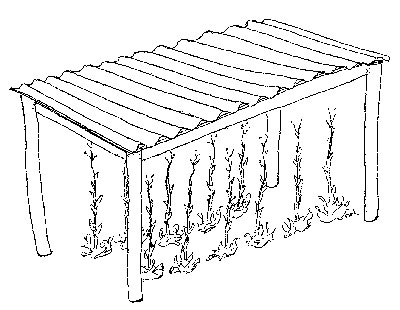 |
| Illustration I: Shed roof for lettuce seed crop |
The simplest structure is made from sapling posts as uprights and light lumber (e.g., strapping) as vertical “joists,” which support sheets of lightweight plastic roofing material (see Illustration I). A fancier version was manufactured using metal posts for the frame and a rigid plastic greenhouse material for the roof. In either case, the roofing material is screwed or tied onto the frames, which are at least 5 feet tall and effectively shed direct rainfall off the plants. As the sides of these structures are open, some wind, rain and moisture still contact the plants, enough to meet their moisture needs as they are growing, but not enough to cause problems with Botrytis and shattering.
Another solution involves using a simple hoophouse, which many farms utilize in the spring for seedling production and in the summer for heat-loving row crops. In this case, the greenhouse will need to be well vented, as lettuce does not perform well in hot, humid environments. With sides that roll up and beds that are protected from rain all season, the typical single-layered plastic covered hoophouse is almost ideal for lettuce seed crops in the Northeast.
Another problem, which can actually be exacerbated in a hoophouse, is Lettuce Mosaic Virus (LMV). This very harmful virus can be seed-borne, so all growers must address its potential presence and impact. Aphids are vectors for LMV, so they must be controlled and infected plants must be rogued.
Lettuce seed growers also need to control wild lettuce (Lactuca serriola), which cross-pollinates with cultivated lettuces (Lactuca sativa). Although botanically classified as separate species, they are closely related, as one probably descended genetically from the other. Studies have shown that L. sativa can be pollinated by L. serriola, with detrimental effects to its eating quality and the purity of the variety. Control of wild lettuce in field edges and ditches is required.
A final challenge is to efficient extract and clean the seed from mature, dried plants. Each lettuce flowerhead has up to 25 florets, each containing one seed, and each seed has a tiny, white, feathery protruberance attached to it, all of which can easily mix together during threshing and winnowing. The weight, size and density of the chaff vs. the seed is close enough to cause problems with inexperienced seed cleaners, and screens and fans and other household items may not do a suitable job unless one has been trained to use them effectively. Many growers utilize simple hand tools at home, while others rely upon a mechanical seed cleaner (like a small, electric winnower with adjustable wind and screening capabilites – machines that some of the seed companies in the Northeast have and let their seed growers use).
Most experienced lettuce seed growers make every effort to separate the seed from chaff, dirt and fluff to begin with. The prudent process involves cutting the entire plant when just over 50% of the seedheads are mature (at their white “feathery” stage), bringing whole plants indoors and setting them on a tarp or a sheet to continue maturing and drying for another week or so, then tipping the dried plants upside down and shaking out as much seed as possible. Crushing, rubbing or otherwise physically threshing the seed out of the plant will contaminate the mature seed with all kinds of chaff that will subsequently have to be removed, and with immature seed, which is very difficult to distinguish and remove from the mature seed.
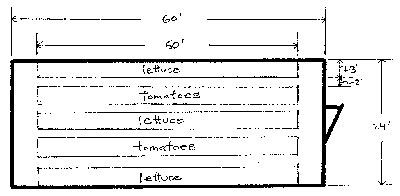 |
| Illustration II: Bed layout in hoop house |
Getting Seeds into the Soil
I have created an example of how a family farmer who already grows vegetables and would like to diversify with some new type of crops can produce lettuce seed. Table A shows neither a composite of all the growers I visited nor a case study of one particular grower, but a generic and readily manipulated model for easy adaptation and comparative study. A reader can look at this “budget” and say, “Well, I can buy compost cheaper than that,” or “I think I would need to spend twice that amount of time threshing and winnowing the seed,” or whatever variations might be evident on a farm.
This hypothetical farm has 2 acres in vegetable production, managed by two full-time employees with some basic equipment, including a rototiller, hand tools, and a single-layer, 24′ x 60′ plastic hoophouse. They divide the growing space within the hoophouse into five 3′ x 50′ planting beds, with 2′ wide paths between each. Lettuce seed crops are grown in three of the beds (Illustration II), while a tomato crop is grown in the beds that separate the lettuce crops. Each bed will hold 100 lettuce plants, spaced 12″ apart in the row, two rows per bed. With the tomato crops as buffers, the farmers can grow three varieties of lettuce for seed.
Growing and marketing several varieties of a given seed crop has great benefits. First, as this niche market develops, the regional seed industry can buy and sell limited amounts of several varieties more readily than large amounts of one variety. Also, as with any farming operation, diversity is a key to success; the grower who can supply a number of interesting and different varieties is better positioned to meet the broad spectrum of gardeners’ and farmers’ needs and interests, particularly as one of the forces behind this niche market is the current demand for little-known and hard-to-find heirloom, old-fashioned and open-pollinated varieties. Finally, varieties can vary in the amount of harvestable seed produced per plant; although not as great a difference as with tomatoes or cucurbits, some types and varieties of lettuce yield more seed than others.
In the example, the three varieties of lettuce are started in flats in the early spring, potted on once into larger flats, then transplanted into the growing beds by late spring. Culture of a lettuce seed crop is similar to a lettuce head crop; fertility needs are high, as lettuce is a heavy feeder and proper amounts of nitrogen improve overall seed yield (extra foliar applications of N, particularly at time of bolting, are said to boost vigor and yield). Irrigation is essential, especially inside a hoophouse. Proper moisture levels produce heavier, healthier heads, which produce larger yields. Either drip irrigation or hand-spraying at ground level is prefered to overhead sprinklers, which can exacerbate disease problems. Irrigation is typically reduced or even abandoned at flowering time. Controlling weeds is important to allow adequate air circulation around plants, lessen nutrient competition, and minimize weed seed contamination of the crop. Rogueing is typically done at the seedling stage and again at heading, though regular inspection is wise.
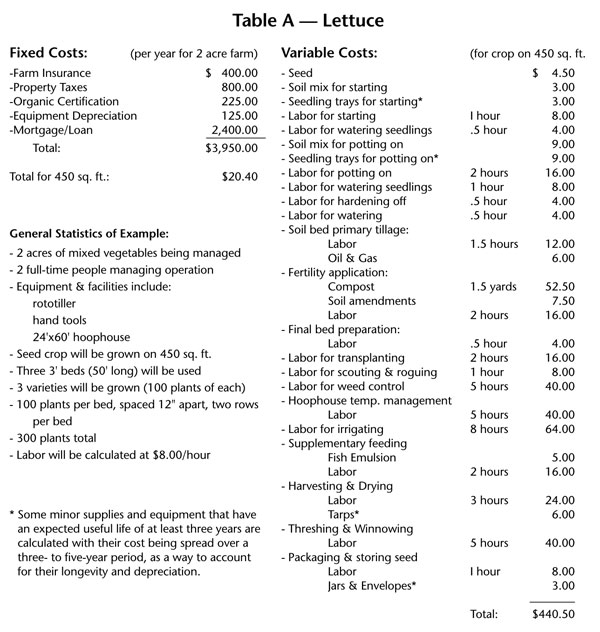 |
Any genetic tendency towards early bolting is important to note. With many crops, particularly in our cool climate, the plants that flower and set seed earliest are desirable, and a seed grower can select and save seed from the earliest ones, and thereby start to develop an earlier strain of that variety. With lettuce, however, one wants to select away from early bolting plants. Indeed, some growers rogue out the first bolting lettuce plants, or at the very least, any plants that diverge from the norm of the population as a whole.
Mature lettuce plants attain heights of 3 to 5 feet under good to excellent conditions and are usually sturdy enough not to lodge. Particularly in a hoophouse, the danger of plants blowing over in the wind and not being able to stand up again is slight, so lettuce plants are rarely trellised or strung up. Simply wait until proper seed maturation and harvest the crop as described above. Cut the plants several inches from the ground with a sharp knife or hand pruners in the morning with the dew on the plants to minimize shattering seedheads and spilling seed.
Growers should trial each variety prior to initiating commercial seed crop production to become familiar with the full life cycle of the plant. Low-yielding or otherwise challenging varieties can be grown successfully if, in advance, the grower has arranged for price premiums or has selected other high-yielding or more profitable varieties to “subsidize” the other.
Note that the farmers in our example purchase their inputs (e.g., soil mix, compost, etc.) and use a common foliar spray (fish emulsion) to supplementally feed the crop, and they irrigate by hand with a wand sprayer and hose. Many of the growers I visited varied from this model, either in producing their own compost, not using supplemental feeding, or by irrigating with soaker hoses or drip tape. All of these variables affect the bottom line of the Variable Costs column in Table A, and should be calculated for each individual grower.
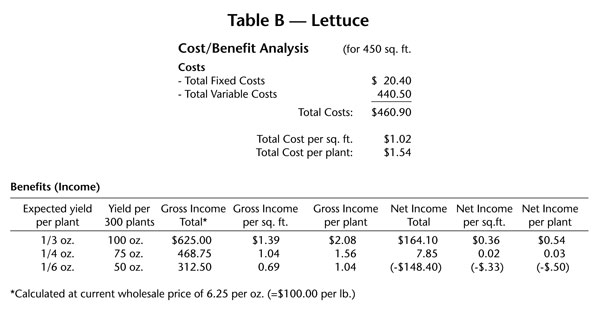 |
Growers may choose varying techniques to grow lettuce to seed. If grown in the field, irrigation probably wouldn’t be needed. Most growers start their lettuce plants indoors, while others have had success direct seeding. No special tools or equipment are required for lettuce seed production (other than structural protection from rain – which some growers do without, as well). The seed crop is grown identically to a lettuce crop that is grown for vegetable use, so the farmer who has a good system of lettuce production has little to do to incorporate lettuce seed crops into the operation.
Looking at the Numbers
I used three sets of figures to represent a range of yields that reflect growers’ experience and harvest data gathered in this study. Compared with other crops (especially cucurbits and tomatoes), lettuce does not vary widely in either yield or wholesale prices for seed. This makes it easier to estimate and/or negotiate the potential profitability of the crop.
Table B shows a simple cost/benefit analysis. The fixed and variable costs of our hypothetical farm (Table A) are added to determine the total cost of production for the three beds of lettuce. Costs per square foot and per plant are then calculated, reflecting those actual costs for each bed. Expected income can then be calculated using three yield figures to show the total gross sales, the gross sales per square foot, and the gross sales per plant for each possible yield. These sales are based on a current wholesale price of $100.00/lb. (or $6.25/oz.), a price that is near median, though some seed companies do pay more than others.
The cost/benefit analysis for wholesaling lettuce seed gives useful yield-to-sales relationships that help define what can or cannot be profitable. The net income is calculated by subtracting appropriate costs, which in this case include the fixed and variable costs (which, remember, included labor at $8.00 per hour, materials and other farm costs).
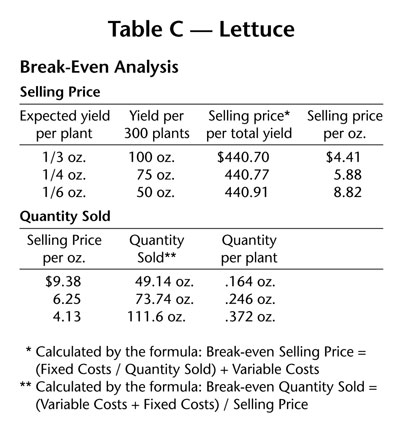 |
With average yields of 1/4 oz. seed per plant (about 1-1/2 lbs. per 100 plants), we can attain a modest profitability (Table B). Good yields of 1/3 oz. per plant (about 2 lbs. of seed per 100 plants) are most profitable. Yields close to 1/6 oz. per plant (about 1 lb. per 100 plants) are not profitable. These figures can be used to project or assess the point at which a lettuce variety produces yields that give positive net returns, or to determine at the end of the season the point at which a crop’s yield should have been or was profitable.
Table C shows a simple break-even analysis, which is used to produce two separate calculations: First a selling price (given the yields and the fixed and variable costs) at which the grower will “break even” (i.e., cover costs but not make a profit); then, the quantity needed to be sold at a given selling price (in relation to the fixed and variable costs) to break even.
The calculations show that for yields of 1/3 oz. and 1/4 oz. per plant, the break-even selling prices are well below “average” wholesale prices, indicating certain potential for profit. Our best scenario is where 1/3 oz. seed per plant would break even at $4.41 per ounce. The current average price is $6.25 per oz., so this could provide a $1.84 per oz. profit. With yields of around 1/6 oz. per plant, the operation may become unprofitable; however, if the grower can attain a wholesale price of $8.82 per oz. or more, then the crop will break even or be profitable.
In the final analysis, the break-even quantity sold, figures suggest a range of possible profitable models based on three selling prices. When selling prices above or below the average are examined, the quantity of seed needed to be sold to break even rises or drops proportionately, showing a target amount that will, at that price, cover the farmer’s costs and allow the venture to break even. Clearly, the current average wholesale price for lettuce seed ($6.25/oz.) is sufficient to make a modest yield of about 1/4 oz. seed per plant economically viable. Prices as high as $9.38/oz. (about $150.00/lb.) can allow a grower to break even at just under 1/6 oz. seed per plant (so yields above this will be quite profitable). Yet prices as low as $4.13/oz. (about $66.00/lb.) require a yield of at least 1/3 oz. per plant to break even.
These calculations can help interested farmers determine a fair and profitable price in relation to yield. Current wholesale prices shown here correspond with yields that are realistic and replicable on most well-managed vegetable farms in the Northeast.
Conclusions
Lettuce is a relatively easy and rewarding seed crop to produce in the Northeast. Little more is required than some protection from fall rains and a basic knowledge of seed saving (the Maine Seed Saving Network, PO Box 126, Penobscot, ME 04476, is a good resource for further information). With the many types and varieties of lettuce from which to choose, and given the popularity of this summer salad ingredient, entrepreneurial farmers have much to explore when considering lettuce seed crop production.
Nonetheless, market research is paramount before planning and planting such crops. A farmer must know who is going to buy the seed, what varieties are wanted, and what prices are likely to be paid, prior to considering growing a lettuce seed crop.
Unlike some of the other potentially profitable seed crops examined in this study (i.e., tomatoes and cucurbits), lettuce crops offer little value-added potential for further profitability. The lettuce plant seems to have very little other value for eating or processing at its mature seed stage other than the value of the seed itself. Picking many leaves from the young growing lettuce heads in the beds is not recommended, other than for an occasional taste or sample, for the large and more vigorous the mature head, the better the seed yield. Retail packing and marketing the seed through one’s own catalog or farmstand is possible, though costs will increase above those presented here for wholesaling, so the economic viability would have to be the subject of a different study.
All in all, a small-scale organic family farm in the Northeast can readily incorporate lettuce seed crop production into its diversified operation and enhance its profitability. Lettuce is a seed crop that is in demand, can open new markets and further diversify a family farm, and can be economically viable.
Contact the author at Maine Seed Saving Network (MSSN), PO Box 126, Penobscot ME 04476.

